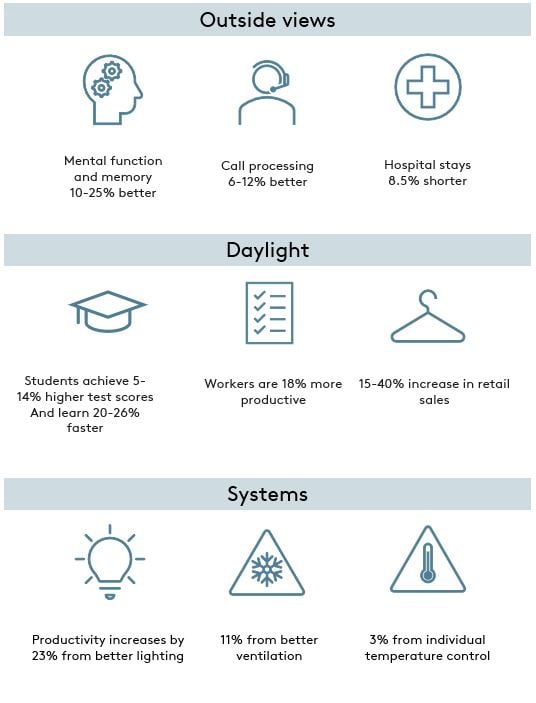At work
As air is a basic human need, the quality of it is vital. Just as we instinctively feel that 'sea air' or 'country air' is cleaner and fresher than the air in our cities, so the air quality in our places of work varies, and can have a significant impact on health and productivity.
The office environment
The physical office environment and its location has an impact on the health, well-being and productivity of employees.
The office environment is made up of several factors, which can be measured or evaluated in numerous ways.
Occupants health outcomes
Physical office factors can influence the health of occupiers. This can be measured or evaluated with some of the below indicators:
- Headaches
- Eye strain/damage
- Skin irritation
- Infections
- Fatigue
- Seasonal affective disorder (SAD)
- Asthma and breathing disorders
- Stress and depression
- Other physical complaints, like back ache
- Other serious disorders, including cardio-vascular
Occupants' well-being and perception outcomes
An occupant's sense of wellbeing is also comprised of their perception of numerous factors, including how productive they think they are. We can use the below measures to gauge well-being in the office environment:
- Perceived physical health
- Perceived psychological health
- Perceived productivity
- Perceived office environment
- Perceived organisational culture


Productivity, performance and effectivity
Productivity is about how much work is completed. The aim is to maximize productivity. Efficiency is about working optimally. The aim is to work and create qualitaty-based outcomes. Productivity and efficiency are intertwined.
An efficient workplace is a working environment - encouraging productivity, enhancing job satisfaction, and minimizing errors and delays. A positive and supportive work culture can encourage employees to perform at their best, promoting safety, growth, and goal achievements.
Good indoor climate and ventilation in the workplace can significantly impact employee productivity, morale and even safety.
- Improved productivity
- Improved employee comfort
- Reduction in sick days
- Regulated energy use
- Regulated energy costs
- Creating a positive atmosphere

The indoor environments at office should help people feel, think and perform better.

Organisational and financial outcomes
The office environment can have a direct impact on occupant productivity, in which health and wellbeing is often a compounding factor.
This outcome for the organisation can be measured or evaluated in some of the following ways, all of which have financial implications for the employer:
- Productivity
- Absenteeism
- Presenteeism
- Staff turnover/retention
- Revenue
- Medical costs
- Medical complaints
- Physical complaints
- Task efficiency and deadlines met
Working hours
"The length of the work day fell sharply between the 1880s, when the typical worker labored 10 hours a day, 6 days a week, and 1920, when his counterpart worked an 8-hour day, 6 days a week. By 1940 the typical work schedule was 8 hours a day, 5 days a week. Although further reductions in work time largely took the form of increases in vacations, holidays, sick days, personal leave, and earlier retirement, time diary studies suggest that the work day has continued to trend downward less than 8 hours a day."
Dora Costa, Economist
Increasing productivity
The declines in the length of the work day and the number of working days have been driven by several factors, including increases in productivity and the adoption of regulations that limit working hours.

What do we get back in return?
Maximised Return on Investment, the financial evaluation based on life cycle costing that includes capital and operational, for all strategies designed to benefit occupants and improve productivity.
- Lower employment cost per employee, including reduced absence costs
- Higher staff retention and reduced costs of staff turn-over
- Greater ease of high quality recruitment, lowering recruitment costs and adding value
- Greater productivity of staff on core tasks
- Optimised green building ratings resulting in higher value/lower risk/ improved reputation
- Reduced occupant complaints via ‘Help Desk’ and other similar feed-back systems, leading to reduced costs
- Increased company revenue
Effects on performance in offices
The numbers don't lie
- Every 1°C reduction in overheating increases the employee’s performance by 3.6%.
- Every 1 litre per second per person (l/s/p) increase in ventilation increases the employee’s performance by 0.8%.
- Every 100 lux increases in lighting level increases the employee’s performance by 0.8%.
- On average, better daylight is connected with a 10% increase in performance.
- For every 1 dB decrease in excess noise, performance is improved by 0.3%.

Watch: Thermal and indoor air quality effects on the performance of office work
Lecturer: David P. Wyon
Webinar recording from the Swegon Air Academy, 2015.
In this video you will find information on thermal and air quality effects on the performance of office work.
It summarises the following findings:
- Workrate is 8% lower at 27°C (slightly warmer) vs. 20°C (cool) when clothed for 25°C (neutral)
- Bioeffluents and emissions reduce workrate
- Relative humidity below 20% affects eyes & reduces workrate
- Effects of temperature, pollutants and noise accumulate
- Individual choice improves performance
Read more from other sources
Working environments, which are inadequately designed from the building physical point of view (acoustics, indoor climate, lighting, air quality), have an impact on health, thermal comfort and performance of the people.The Fraunhofer Institute